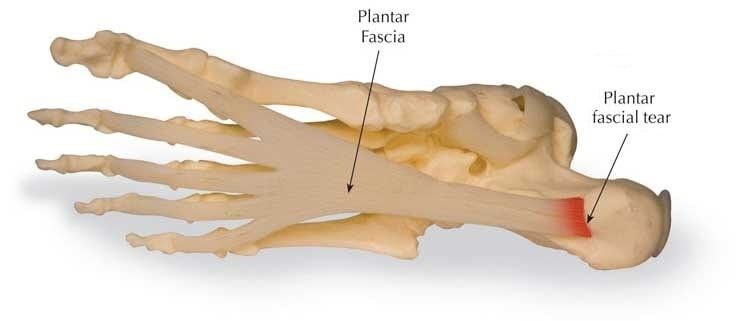Case Study: Heel Pain from Plantar Fasciitis in 38 Year-Old Female
Presentation- Plantar Fasciitis?
A 38 year old female presented at the Sydney Heel Pain Clinic with heel pain in her right foot, consistent with plantar fasciitis. She reported that she had been suffering with heel pain for around 6 months. The patient told the sports podiatrist that she had joined her local health club about 6 months ago and she was participating in step aerobics classes 2-3 times per week. The patient was slightly above a healthy BMI but reported that she had been steadily losing weight (she had already lost 8kg in 6 months). Occasionally (approximately once a week) she would have cramping in her calves in the evening after a big day on her feet. She was otherwise healthy. The patient was a busy mum of 3 kids, and she was concerned that her heel pain would get worse and that the plantar fasciitis would stop her from doing things with her children.
Pain Symptoms Consistent with Plantar Fasciitis
The description of her heel pain was consistent with plantar fasciitis. She described that her pain was worst first thing when she stood up out of bed. The pain felt like a stone in her heel. She said that the heel pain would subside and feel more like a dull ache after a few minutes of walking around.

The patient told the sports podiatrist that her pain was manageable whilst she was exercising, but she was often so sore following her aerobics class that she would roll her foot over a frozen water bottle for relief and then spend some time lying on the couch. This provided her some temporary relief but when she stood up, she would feel the heel pain from the plantar fasciitis again.
Plantar Fasciitis Home Remedies Tried by the Patient
The patient told the sports podiatrist that she had discussed her heel pain only very briefly with the GP a couple of months ago, and the GP had mentioned that she may have plantar fasciitis, though she never returned for a proper diagnosis or treatment. She had searched ‘plantar fasciitis’ on the internet, and based on the information she’d found, she had been trying some treatments at home. The patient had been using a frozen water bottle to ice-massage her sore foot. She was also performing some stretches for plantar fasciitis that she had watched in a YouTube video, but admitted that she often forgot to do these on a regular basis. The patient had seen an advertisement on the internet about some plantar fasciitis socks, but she was unsure whether these would work. She reported to the sports podiatrist that very occasionally she would take ibuprofen if the heel pain from the plantar fasciitis became severe.
The patient’s husband recommended to her that she visit a sports podiatrist for a correct diagnosis and treatment, as he was concerned that she was becoming increasingly sore.
Examination to Assess Patient’s Plantar Fasciitis
The sports podiatrist carried out a thorough physical examination in order to confirm the diagnosis and assess the severity of the plantar fasciitis. As the sports podiatrist palpated the sore foot, the patient reported a lot of pain in the central area of heel. There was also some pain in the plantar area, where the plantar fascia attaches to the heel bone. She was able to successfully perform a single leg heel raise on the affected leg without notable pain. The sports podiatrist performed some further physical tests on the range of motion in the foot and ankle joint, and on the muscles, ligaments and tendons in the lower leg and foot. The sports podiatrist’s examination revealed tight calf muscles in the patient’s legs, but more so in the right leg. No further abnormalities were detected.
The patient was notified that her clinical signs and symptoms were consistent with a diagnosis of plantar fasciitis, but reassured her that her condition was treatable.
Biomechanical Assessment for Plantar Fasciitis
During the physical examination for plantar fasciitis, the sports podiatrist also conducted a biomechanical assessment and gait analysis on the in-house treadmill. Markers were placed on the patient’s lower leg and foot and the footage of the patient running on the treadmill was recorded. An analysis of foot strike was then carried out in slow motion. Arch height and heel angle were measured.
Footwear Assessment for Plantar Fasciitis
Following the examination and biomechanical assessment, the sports podiatrist assessed the patient’s footwear. The patient had a pair of branded minimalistic-style running shoes, which she was using for step aerobics classes and also during running her daily errands. It was determined that her current runners were not providing sufficient support for her foot. This is likely to have been a major contributing factor in the development of the patient’s plantar fasciitis.
Commencement of Treatment for Plantar Fasciitis
Treatment for plantar fasciitis is often based around the findings of the treadmill assessment and physical symptoms. The aim of the treatment for this particular case of plantar fasciitis was to reduce inflammation and relieve pain, whilst at the same time allowing the plantar fascia ligament to heal.
The sports podiatrist devised a treatment plan with three main components:
- Change in footwear
- Strapping
- Stretches for the calves and plantar fascia
- Shockwave therapy
The patient was shown some stretching techniques by her sports podiatrist. The exercises were selected in order to help with increasing flexibility in the calf muscles- which would also help with the patient’s cramping- and releasing the foot and ankle, and therefore allow the plantar fascia to heal. The sports podiatrist explained to the patient that she should set an alarm to remind her to complete her exercises at intervals throughout the day.
In order for the plantar fascia to recover, the patient was recommended to purchase a new pair of shoes. This particular patient was advised that for her foot type, the Brooks Adrenaline GTS would be most appropriate to adequately support the architecture of the foot without placing any undue pressure on it.
Shockwave therapy is a scientifically proven treatment for plantar fasciitis. It can provide instant pain relief, encourages tissue regeneration and stimulates blood flow to the area. The patient was scheduled to receive four shockwave therapy treatments over the course of four weeks. Rigid sports tape was applied to the affected foot and was to be re applied at each session.
The sports podiatrist recommended to the patient that during her treatment for the next 6 weeks, she should not participate in step class. She was advised and choose another activity instead that would not be high-impact for her feet, making sure to warm up prior to exercising. Some options were aqua aerobics, swimming, or upper-body boxercise.
Plantar Fasciitis Socks?
With regards to the patient’s question regarding plantar fasciitis socks for treatment, the sports podiatrist advised her that there is a lack of evidence available regarding their efficacy. The patient would be receiving scientifically proven methods of treatment for her plantar fasciitis, so there would be no need to purchase plantar fasciitis socks.
Plantar Fasciitis Treatment Outcomes
The patient received her first shockwave therapy treatment on the day of consultation. She tolerated the treatment well. She reported that she experienced pain relief immediately following her treatment.
The following treatment was one week after the first. This second treatment also provided the patient instantaneous pain relief. The patient also reported that she had been completing the exercises that the sports podiatrist had prescribed.
In the following two weeks, the patient received two more shockwave therapy treatments for her plantar fasciitis.
A follow-up consultation was scheduled by the sports podiatrist for two weeks after the final shockwave therapy treatment. The patient was pain free. She reported that her new shoes felt so supportive on her feet, and she had been compliant with the exercise program that her podiatrist has suggested for her. She was advised that she could return to her step aerobics class, but should begin by using the lowest step and following the low impact option, if the class instructor gave one. If she was still pain free for 2 weeks, she could progress.
Please be advised that this case study is unique to the individual patient. Any reference to treatments should not be taken as general medical advice. If you have heel pain or you suspect you may have plantar fasciitis, you should consult with a qualified sports podiatrist for an assessment and correct diagnosis.
Book online
Podiatrist – Fatmeh Abdi
Sydney Heel Pain Clinic
93883322
Written by Karl Lockett





